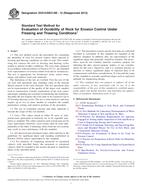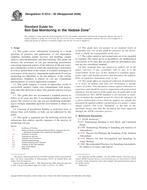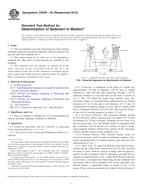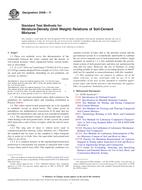Potrebujeme váš súhlas na využitie jednotlivých dát, aby sa vám okrem iného mohli ukazovať informácie týkajúce sa vašich záujmov. Súhlas udelíte kliknutím na tlačidlo „OK“.
ASTM D425-88(2008)
Standard Test Method for Centrifuge Moisture Equivalent of Soils
Automaticky preložený názov:
Štandardná skúšobná metóda pre Centrifúga vlhkosti ekvivalentu pôd
NORMA vydaná dňa 1.2.2008
Informácie o norme:
Označenie normy: ASTM D425-88(2008)
Poznámka: NEPLATNÁ
Dátum vydania normy: 1.2.2008
Kód tovaru: NS-26575
Počet strán: 4
Približná hmotnosť: 12 g (0.03 libier)
Krajina: Americká technická norma
Kategória: Technické normy ASTM
Kategórie - podobné normy:
Zemní práce. Hloubicí práce. Budování základů. Podzemní práce
Anotácia textu normy ASTM D425-88(2008) :
Keywords:
centrifuge moisture equivalent, specific retention, specific yield, storage capacity, water holding capacity, Centrifuge moisture equivalent, Soil, Soil-moisture analysis, Specific retention/yield, Storage--soil/rock/related materials, Water analysis, Water-holding capacity, ICS Number Code 93.020 (Earth works. Excavations. Foundation construction. Underground works)
Doplňujúce informácie
| Significance and Use | ||||||||||||
|
Not all water contained in a saturated soil can be removed by gravity drainage. The amount of water retained after gravity drainage is usually expressed as water holding capacity or specific retention. It varies with time, and with the particle-size distribution and plasticity of the soil (in general, increasing in value with increasing plasticity index). In general, the centrifuge moisture equivalent is based on the theory of applying a centrifugal force great enough to reduce the capillary fringe zone enough that it can be ignored without introducing much error, even in small specimens, and yet not so great as to withdraw a large proportion of the water that is held securely above the capillary fringe. For example, if a soil will hold water 100 mm by capillarity acting against gravity, the soil will theoretically be able to hold the water only 0.1 mm against a centrifugal force that is 1000 times greater than the force of gravity. It has been determined that for at least medium-textured soils (sandy to silty particle-size distribution) the centrifuge moisture equivalent approximates the water holding capacity and when combined with the bulk density can be used to calculate an approximate specific retention and specific yield. These properties when combined with porosity can be used to estimate aquifer storage coefficient. |
||||||||||||
| 1. Scope | ||||||||||||
|
1.1 This test method covers the determination of the moisture equivalent of soil in the laboratory by means of a centrifuge technique. 1.2 This test method is limited to disturbed specimens of coarse-grained soils having fines of low plasticity such as SP, SW, SC-SM, or SM soils. The test is limited to soils passing the 2.00-mm sieve or that fraction of a soil passing a 2.00-mm sieve. Note 1—Test Method D 3152 or Test Method D 2325 should be used to evaluate the capillary-moisture relations of fine-grained soils and coarse-grained soils having fines of medium to high plasticity, undisturbed soils, and soils at specific desired units weights. 1.3 The test method is temperature-dependent, and consistent comparable results can be obtained only if the tests are performed under a constant-temperature condition. 1.4 The values stated in SI units are to be regarded as the standard. 1.5 This standard does not purport to address all of the safety concerns, if any, associated with its use. It is the responsibility of the user of this standard to establish appropriate safety and health practices and determine the applicability of regulatory limitations prior to use. |
||||||||||||
| 2. Referenced Documents | ||||||||||||
|
Podobné normy:
Historická
15.1.2013
Historická
15.1.2013
Historická
1.7.2006
Historická
1.6.2014
Historická
1.4.2012
Historická
1.1.2011
Odporúčame:
EviZak - všetky zákony vrátane ich evidencie na jednom mieste
Poskytovanie aktuálnych informácií o legislatívnych predpisoch vyhlásených v Zbierke zákonov od roku 1945.
Aktualizácia 2x v mesiaci !
Chcete vedieť viac informácii ? Pozrite sa na túto stránku.



 ASTM D5312/D5312M-12..
ASTM D5312/D5312M-12.. ASTM D5313/D5313M-12..
ASTM D5313/D5313M-12.. ASTM D5314-92(2006)..
ASTM D5314-92(2006).. ASTM D5335-14
ASTM D5335-14 ASTM D5439-95(2012)..
ASTM D5439-95(2012).. ASTM D558-11
ASTM D558-11
 Cookies
Cookies
